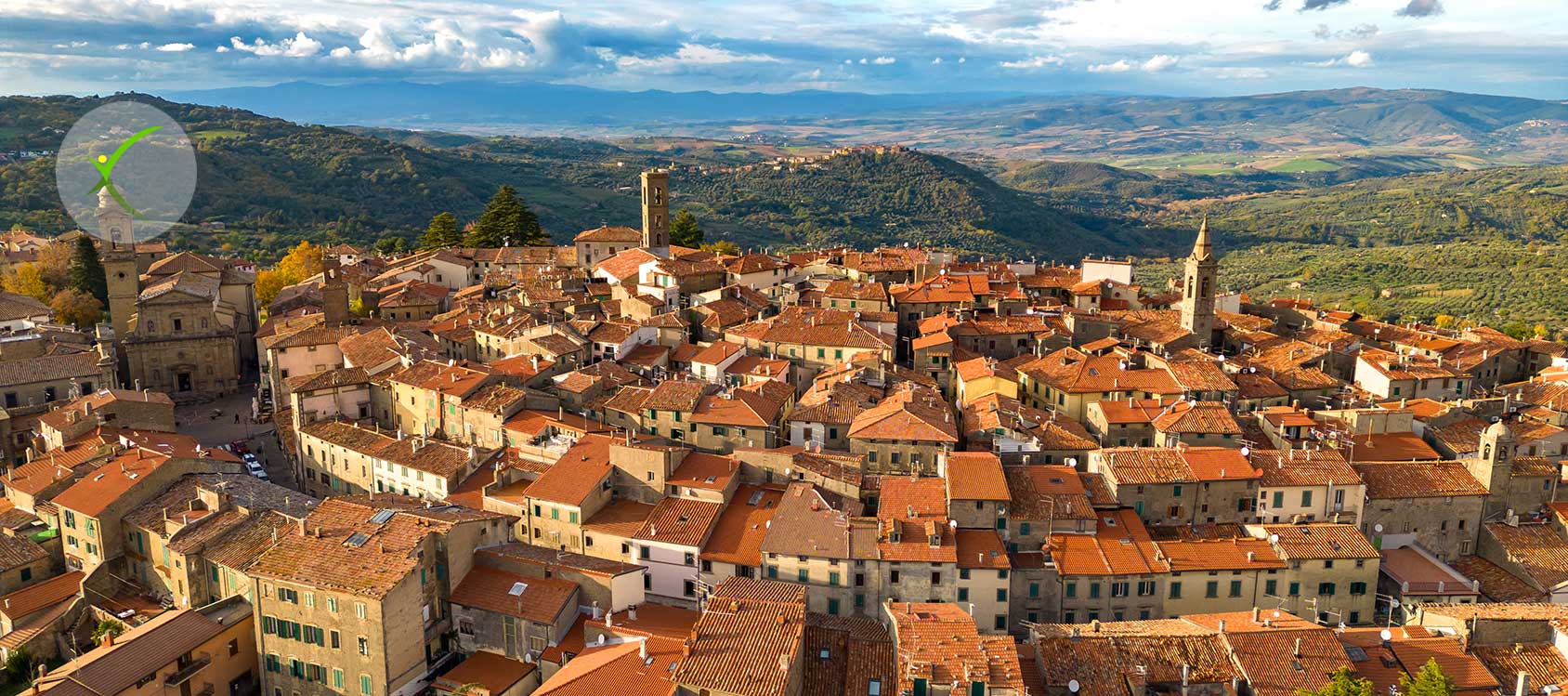Castel del Piano is a small village that stands on the slope of Mount Amiata in province of Grosseto in Tuscany.
Now imagine you are a medieval commoner who lives in the municipality of Castel del Piano. Even in that period, after exhausting days of work, there was a moment of play and celebration where citizens participated actively and with great spirit. In fact, as early as the mid-1400s, there is evidence of races with horses or donkeys in the Grosseto town; but it is since 1771 that they have taken place with certainty, given that they have been documented, races “alla tonda” in the days preceding September 9. This is the day dedicated to the “fiera delle merci e del bestiame” (fair of goods and livestock) since ancient times. To date, clearly, the fair has evolved with the society.

The historic centre
Castel del Piano has a particular urban structure, especially with regard to the three avenues that branch off from Piazza della Rimembranza. These follow the style of Piazza del Popolo in Rome. It is a unique structure in Tuscany and was considered cutting-edge when it was conceived and created. The town has medieval origins and was under the power of the Aldobrandeschi, the Republic of Siena and Florence. The historic centre is nice and well organized and allows us to imagine what life might have been like in the 11th century. Walking through the cobbled streets, you can admire buildings, unique views and some very particular panoramic points. Very emblematic is the Clock Gate where the Clock Tower “controls” the entry of travellers into the ancient part of the village.
Palaces and churches
In the Amiata area, there are some buildings that have a certain historical value. Some of these are Palazzo Ginanneschi and Palazzo Nerucci, which houses the civic museum. Walking through the town, you can also see many sacred buildings. The church of the Opera and San Giuseppe has the largest structure in the entire Amiata area. The façade has baroque characteristics and inside there are paintings by the Nasini. The Church of the Madonna delle Grazie shows a nineteenth-century façade in peperino stone. Inside there are paintings by Francesco Nasini.
If we continue our walk through the town, we also notice other sacred buildings: the church of San Leonardo, the Church of the S.S. Sacramento and the Church of San Giuseppe.
If you have the possibility of travelling by any means of transport, you should visit the small centre of Montegiovi, a hamlet of Castel del Piano and a few kilometres away. The ancient village is located on the top of a hill and dominates the valley below, arousing emotions in the visitor.
Palio delle Contrade
The Palio takes place each September 8th in honour of the Madonna delle Grazie. It is held in the Piazza Garibaldi which has the characteristics similar to Piazza del Campo in Siena. In fact, there are descents, climbs and sharp curves. In the days leading up to the Palio, the square is covered with clay, in order to allow the horses to run safely. This has been the most important event since the Middle Ages. All citizens dream with it and everyone looks forward to the result and the moment of celebration.
Events
Many events are held in the Grosseto town during the year. Most of them take hold during the summer months when the weather is also more clement. Two motorbike rallies are organised, one in the summer and one during the chestnut festival in October; equestrian festivals, dog shows, concerts, pasta and cod festivals, exhibitions and fairs. It is a town that always tries to keep up with the times.
In recent years the “Gora Summer Festival” has acquired greater importance. It is an event that takes place in August at the Parco dei Cigni and combines music, art, culture, and children’s educational events.
The most special nights are those of the propitiatory dinners preceding the Palio. They are nights of frantic waiting, of assumptions, of mockery, of predictions and memories of previous races. The various city quarters organize banquets where joy, laughter, good food and a few glasses of wine always reign. All this accumulated electricity is released on the day of the Palio when a single horse will cross the finish line first and the hopes of glory for the other three city quarters will vanish, at least for another year. On the other hand, events and circuses have animated the Ciola population since the Middle Ages and the various factions will continue to compete for the prize ad infinitum.
Things to do in Castel del Piano
When you arrive in this beautiful village, you have the feeling of having reached a place where you can stop for a long time, quiet, sunny, close to the chestnut groves of the Amiata, the Albobrandeschi castels and with many attractions to visit. It is full of historic churches and noble palaces. Below is a list of the things that you shouldn’t miss during your stay:
- Church of San Leonardo, Church of Santi Niccolò e Lucia, Pieve di Santa Lucia, Church of the Madonna delle Grazie, Church of San Giuseppe, Church of Santa Lucia, Convento delle Minime del Sacro Cuore, built in the 16th century as a hospital, Palazzo Nerucci dating back to 1564, Palazzo Cerboni, Palazzo Monaci, Palazzo Venturini, Palazzo Pretorio, Walls, dating back to the 12th century, Museum of Vines and Win
If you need more information on the history of this village, you can visit WikiPedia Page.









